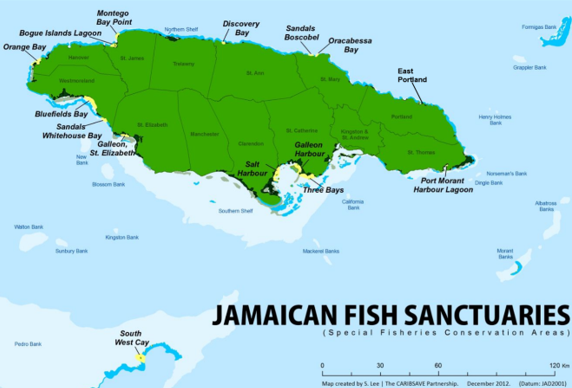N.L. Guyah setting light traps in Discovery Bay. Photo credit: Daniel Scarlet.
Jamaica has more than 18 fish sanctuaries developed in response to its depleted fish stocks. Within these marine protected areas, special fishery conservation areas (SFCAs) play a special role by prohibiting fishing while promoting habitat restoration and research activities. SFCAs are necessary for protecting juvenile fish and their preferred habitats, facilitating fish growth to stages where survival is more likely, providing a source of fish eggs and larvae, and allowing spill-over of adult fish to replenish the fishing grounds outside the sanctuary. However, if SFCAs are to be successful, they have to be effectively monitored. In the study “An assessment of the larval fish diversity within a coastal marine reserve” published in Regional Studies in Marine Science, FST graduate student N. Guyah along with her supervisors Prof. M. Webber and Dr. K Prospere (Department of Life Sciences) propose sampling protocols for better monitoring of SFCAs and their effective management.
The study was conducted in Discovery Bay which, though one of the oldest fish sanctuaries in Jamaica, is yet to consistently demonstrate success. Fish stock assessments have previously been conducted in the Discovery Bay SFCA, but very few have focused on mapping the ichthyoplankton or fish eggs and larvae. Guyah’s study is therefore unique in its assessment of the abundance and diversity of ichthyoplankton and its determination of the most suitable sampling protocols for doing so. The study found that while plankton nets and light traps were complementary based on the range and size of fish species caught, light traps were more cost effective and sampled larger individuals which are easier to identify and are more likely to become adult fish. The study also produced a baseline of larval fish species and abundances along with information on the seasonality of ichthyoplankton abundance and the factors that affect these early life stages of fish. Importantly, the study makes the case for incorporating light traps into the monitoring protocols for Jamaica’s SFCAs so that juvenile fish production can be maximized.

Map of Jamaica’s Fish sanctuaries. Source: https://www.Jamaica-fish-sanctuary-network


